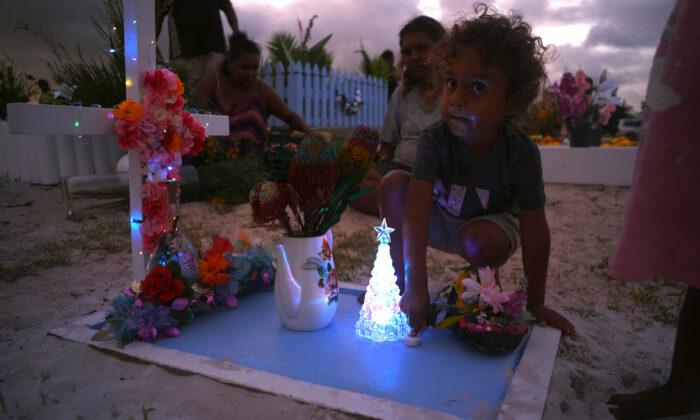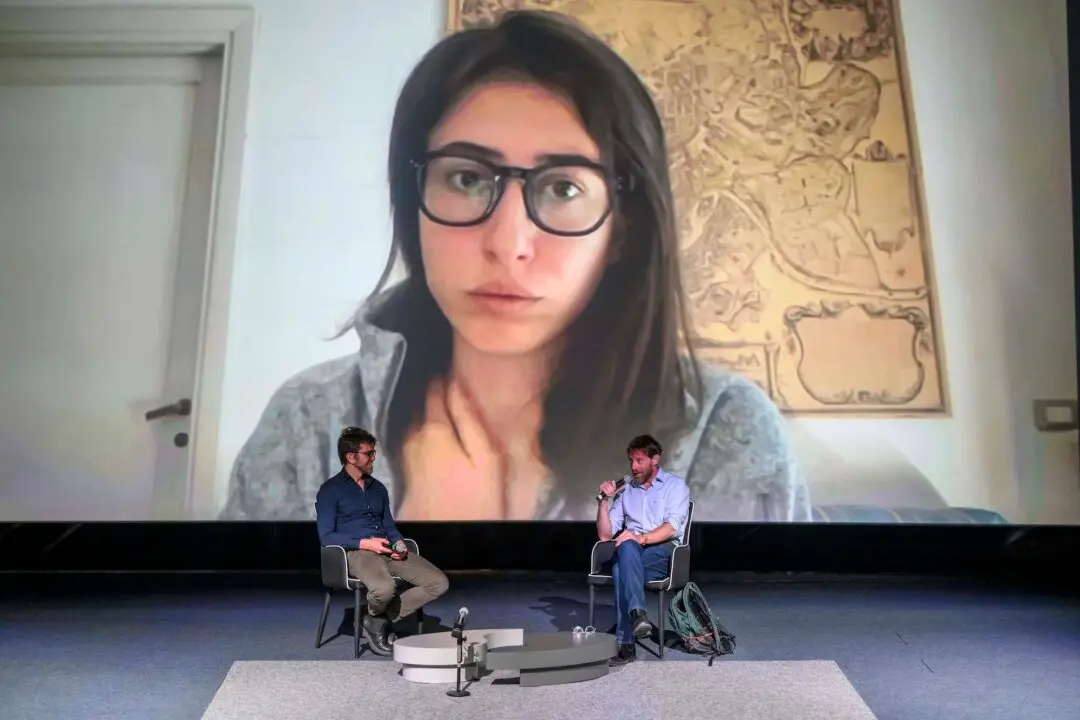The Guugu Yimidhirr people of Hope Vale, an Aboriginal village in the far northeast of Australia, celebrate Easter with a unique week-long tradition held up by four pillars: faith, history, family, and spirit—or “wawu,” as they say in their language.
Wawu: Divine Hope
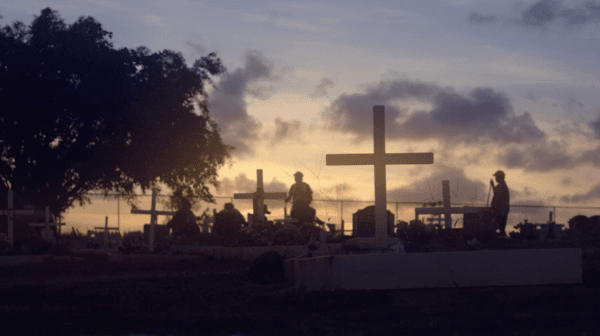
The sun hangs low in the west, painting the clouds behind Hope Vale’s cemetery amber and purple, as a small group makes practiced work of weedy graves.
The family cut sharp silhouettes against the setting sun as they ready the overgrown graves for the men to lay the foundations for concrete. They’re getting an early start on a Tuesday at dusk before the place becomes a hive of activity later in the week.
Sitting amongst graves overgrown with weeds, elder Alice Walker explains why they’ve come, saying: “It only happens once a year, and the graveyard is full of weeds. So we clean the graves, and on Saturday afternoon, we put fresh flowers, ready for Easter.”
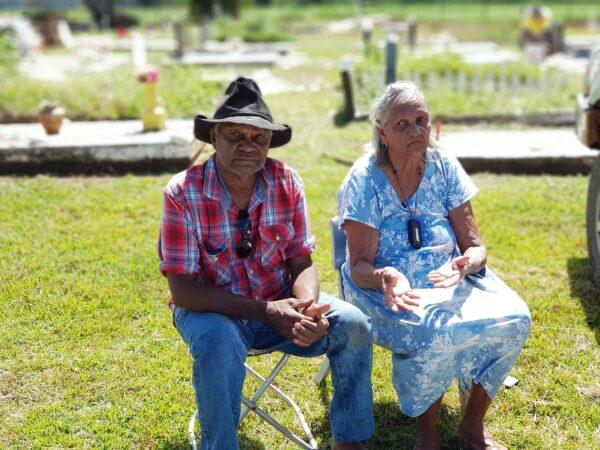
Alice says Easter is an exciting time in Hope Vale. It brings the whole community together in a special way. For her, the tradition is a way to honour the pioneers, like her father, Bob Flinders, who established the community in the 1950s after the Guugu Yimidhirr people were displaced during World War II.
For Deborah Pearson, Easter is a “very special and humbling time” of year, which she says makes her reflect.
“If you’re a believer, then Easter is one of the best times of the year,” she says, referring to her Christian faith. Deborah’s generation grew up in Hope Vale when it was still a Lutheran mission.
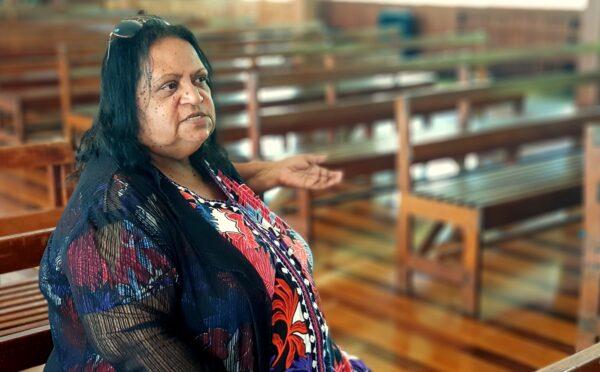
Sitting on a pew in St John’s Lutheran Church across the village, Shirley Costello, the local librarian and retired teacher, explains the Guugu Yimidhirr people’s word for a person’s soul and feelings—wawu.
“Wawu is your inner spirit. The centre of your soul. Without wawu, well, you’re quite empty, and that’s not a good life,” she says.
Shirley says that for the people of Hope Vale, their wawu is steeped in their Christian beliefs, which she says works well with their traditional Aboriginal heritage.
‘We take pride in this church’
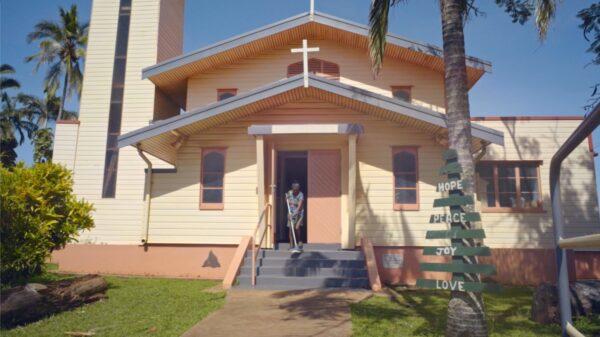
A team of women mop and wash the church in preparation for the upcoming week of Easter services. They move like they’ve done this year after year.
Deborah Pearson says: “We take pride in this church. Everybody helps. Each and every family member contributes. And it’s always kept beautiful.”
Maud Wallace, who works at a school in nearby Cooktown, tells the women they could ask people to donate flowers from their gardens.
“They won’t say no. Make the church pretty!” she declares.
The ladies natter about their to-do lists. Maud is assigned to the windows, while elder Phylamena Naylor, who has organised the cleaning team, says she will position the vases ready for fresh flowers.
The feeling is buoyant, but they’ve come to get the job done.
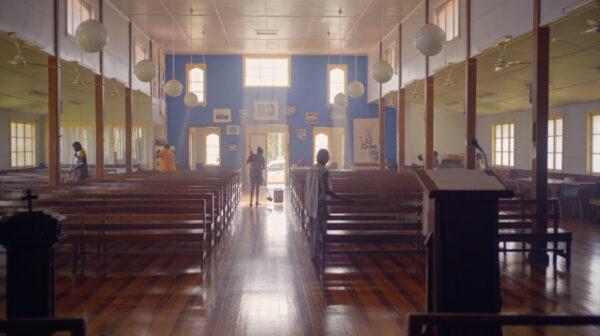
Cheryl Cannon, chair of the church committee, says: “The church was a big part of our families prior. We want to keep that going.”
Two Days Before Good Friday
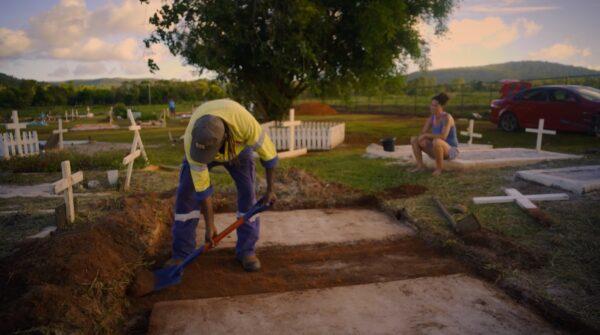
The people who live in Hope Vale love their lifestyle. At Easter, they basically spend the whole week at their cemetery.
When the workday is done, small groups venture up to the cemetery to get an early start on their preparations.
“Well, now they’re just cleaning up, see. And then Saturday, it'll be on,” says Herman Bambie, who is in his 90s says, while sitting beside his now-late wife at the cemetery.
He’s talking about how busy with activity the cemetery will become in just a few days when the whole village comes to tend to the graves of their loved ones.
“That’s why we come up here now because there'll be no room [for us] then,” he adds.
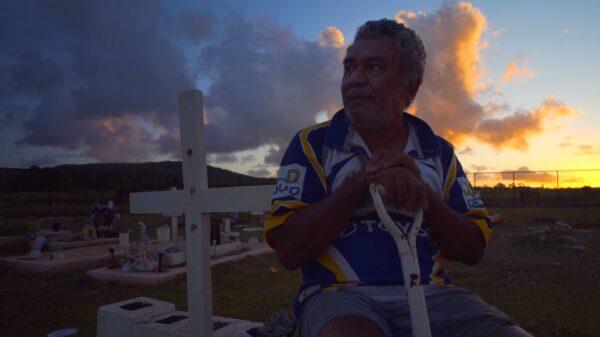
“When Dad passed away in 1999, Mama passed away in February then [of] 2000. Too close [together], see?” Robert Gibson says with a small laugh—his pain, a distant memory.
“At least you can go back home and say, ‘Oh well, you know, I cleaned my brother’s grave, [my] sister’s, [my] cousin’s, you know, [my] nephew’s. And you feel good [about it]. I feel good, you know?”
Singing In Church Reminds People of Their Happy Childhood
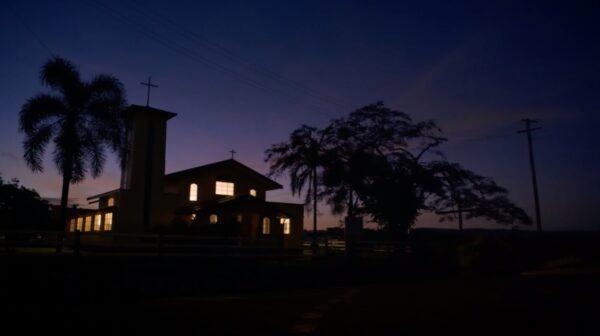
“History [books] tell us that Aboriginal people had a belief. They believed in the sun, the moon, the stars, plants and animals,” says Shirley.
“But you see, when the missionaries came along, they taught our people the fundamentals of Christianity. Like it was God who made the sun and the moon.
“As time went on, we were able to combine the two. We have a god [but] we still have our [Aboriginal] culture, and it works together,” she says.
Inside St John’s Lutheran Church, a group of singers rehearse hymns in English and Guugu Yimidhirr accompanied by a small band.
Selena Bowen explains how some of the hymns use Guugu Yimidhirr words that only the old people are adept at using, so they like to practice.
“We sing songs in both language and English,” says Selena, who has organised the singing group.
“The only reason I’m familiar with those hymns is because of coming to church with my parents every time,” she adds. “We still remember how they sang back then. I feel proud to be amongst our elders, to be singing out aloud, and learning [the language] off them.”
Selena says that it is “in their honour” that they’re getting together to sing at Easter.
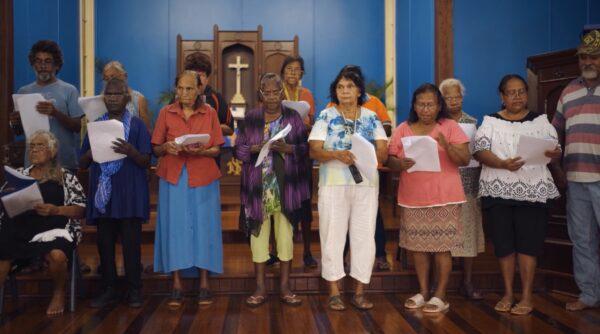
Shirley says the community love events, and the singing groups bring young and old together. She explains how singing came from school activities, and for adults today, singing brings them back to “happy memories of when they were children.” For the children today, she says, “it becomes their history as well.”
Phylamena, who stands wrapped in a purple scarf, says she’s proud to sing in front of the congregation. She says it’s a great way for children to practice their language, so it’s not lost.
The Tradition’s Genesis and Evolution

In the headlands of Cape Bedford, nestled in the beautiful but tough terrain, are the remains of Hope Valley Mission. This is where the Guugu Yimidhirr people lived with their German missionary George Heinrich Schwarz, who they affectionately called “Muni,” for 50 years until 1942.
Populated by tea trees planted over 100 years ago, this is a place full of colour, from the azure Coral Sea to the mineral-rich tea coloured billabongs.
Due west of Cape Bedford is a place known as Jepson’s Crossing. The road to this place is lined with yellow wattles.
Having found a soft place to sit on the bank of the creek, Esme Bowen (70s), Doreen Hart (50s), Estelle Bowen (60s), and Dora light a fire and tell their grandchildren tales of their own childhood memories of Easter, funerals, and the cemetery.
“Everybody had gardens in their yard, and if I needed something from him, I‘d say, ‘I’m going to take some flowers.’ They’d sing out [take it], ‘cause they knew where it was going; it was going back up to the cemetery. ‘Get what you want from here.’ We used to share the plants and everything," Esme says.
Doreen chimes in, “That’s what I was saying, people got a heart! Wawu-thirr (kind), you know? They cared. Very caring people and they shared what they had in order to spread the love, you know?”
They discuss how death was sacred and respected. No one would play loud music or even go fishing when there was a death until the body had been laid to rest. In Hope Vale, no matter who the person is, they get a good funeral, they say. It seems to be one of the shared values that characterise this place.
Doreen adds, “And even the funerals back in the day; the coffin would be loaded with flowers from people’s local gardens. There weren’t any bought in (all the ladies chime in and agree: ‘nothing, no’). They were bouquets made locally, and it was beautiful, you know?”
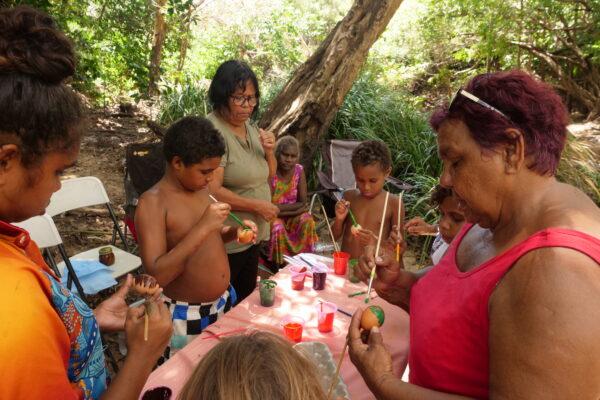
The billy tea is boiling, and biscuits are passed around. Birds twitter, and a breeze rustles through the trees.
“Our parents used to tell us, ‘Get up early ’cause the sun’s going to dance.‘ And we’d wait ’til about seven o'clock and actually see the sun shimmering,” Dora says, referring to a common pious belief among Christians that when the sun rises on Easter Sunday morning, it dances with joy that Jesus has risen.
Meanwhile, as the kids play in the refreshing tea-coloured water, the elderly ladies sit together, talking and laughing while they decorate eggs with paint, reliving the joy of their childhood.
Esme says they didn’t have Easter Eggs when she was a child, but her parents would boil chicken eggs with beetroot to colour them.
“They used to do it for us; these chook eggs; boil the eggs and then paint them. That was our Easter Egg. But we all was too excited for it because we was thinking, ‘This is lovely!’.” The group chatter in agreement.
The kids soon gather around and join in, learning to paint the eggs the way their grandmas did when they were kids.
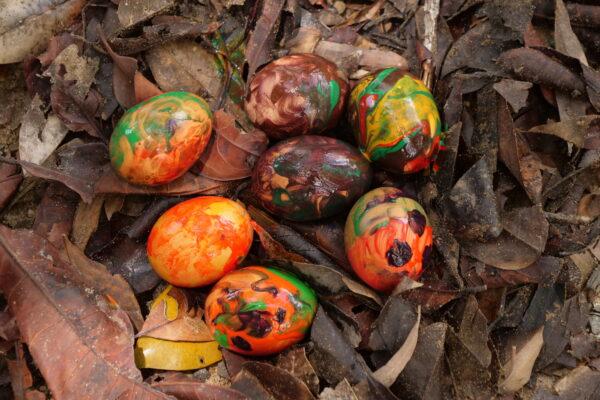
“Easter is always a very exciting time for us,” Esme tells the children. “Our dad used to say, ‘Make your nest.’ When we wake up in the morning here, we'd have a lovely, pretty Easter Egg.”
Esme tells the children the place where they are, Jepson’s Crossing, was where their forefathers were “loaded on the trucks” by American troops in 1942 and “taken away.”
With the Australian government suspicious of their German missionary, the Guugu Yimidhirr people were forcibly relocated 1,500 kilometres (932 miles) south to Woorabinda, another Aboriginal community.
They stayed in Woorabinda for eight years. Many—whole family groups, in fact—never returned.
On a hill above Hope Vale is the unmarked pioneer cemetery.
Desmond Bowen, who is in his sixties, leads a project to restore the original cemetery and create a memorial garden there. Some of the first people who returned from Woorabinda to establish their new home are buried there—within sight of the new cemetery.
Doreen explains the Easter tradition started with her late cousin Wayne Rosendale who suggested a dawn service because no one from Hope Vale went to war. As a young man, he thought a dawn service, inspired by ANZAC Day, was a way to memorialise passed elders and family members who were being forgotten.
Loss, Grief, and Hope: How this Tradition Soothes Aching Hearts
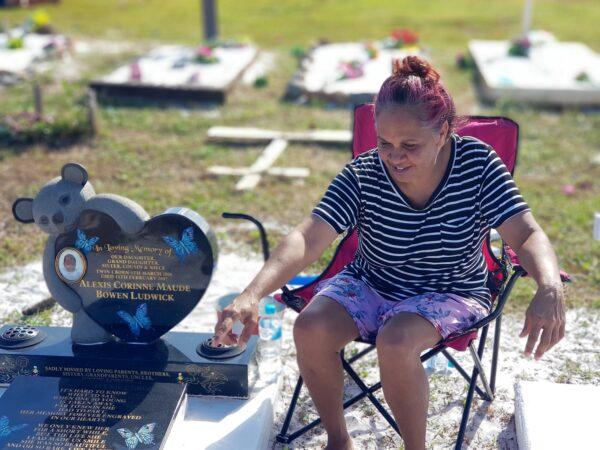
On the Wednesday before Good Friday, Joanne Bowen has come to the cemetery to visit her daughter.
Her children clean and prepare the graves of their loved ones and also tidy up a few neglected graves whose families haven’t been able to make it.
Joanne’s son, Keithan Bowen, who is now on the local council, says he loves how the community comes together at Easter. He finds the whole process therapeutic and explains how this event offers him something emotionally that nothing else does.
Sitting beside the grave of her daughter, who drowned when she was one, Joanne explains that she comes here all year long, whenever she’s feeling lonely.
“The butterfly reminds me of my daughter, Alexis. It’s like she’s just flying around, yeah, like a butterfly,” Joanne says, adding that she pretends her daughter has just gone “on a holiday.”
“I just come up when I’m feeling lonely. Sit down with her. Have my moments, you know?” she says, trailing off, struggling for words and unable to make sense of the tragedy.
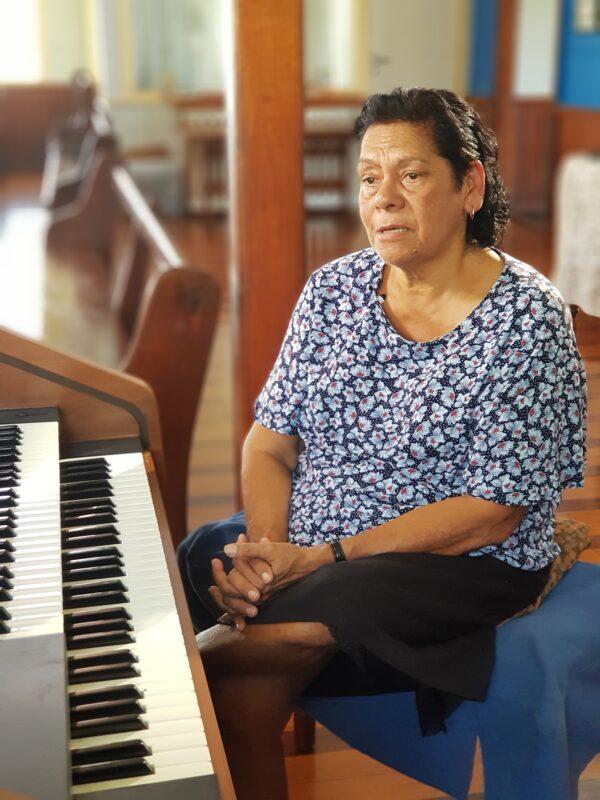
“When you lose your partner or a child, you’ve got that different kind of feeling, and it affects you differently,” says June Pearson, a former long-time councillor, referring to the Easter tradition.
Sitting at the organ inside St John’s Lutheran Church, June says she draws strength from her faith that she’ll meet her husband “on the banks of the river” when she crosses into heaven one day.
She says her faith gives her hope in eternal life and explains the meaning of Easter, for her, is centred around God’s love and that it is a time when Hope Vale gets together and shows care for one another and has a chance to feel closer to their loved ones in heaven.
June, who has been the church organist for more than 40 years, plays her husband’s favourite hymn on the instrument.
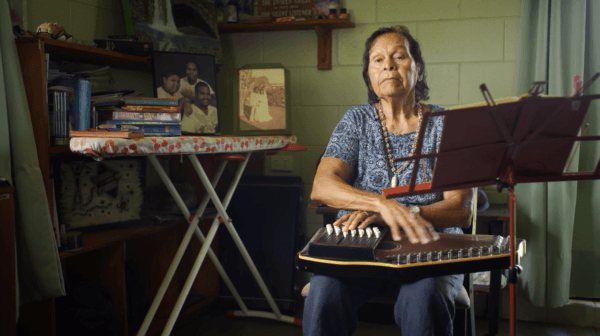
On Maundy Thursday, church elder, the late Dorothy Rosendale, plays her autoharp and sings her favourite song, “How Great Thou Art.”
“I was four years old when I was taken from our mission to Woorabinda,” she says.
As a child, Dorothy watched her father lead worship services in the dormitory at Woorabinda, where they lived while displaced from their homelands.
“I was so proud of him. I never thought that one day I would be doing that,” she says with a laugh.
When Paster David is away, Dorothy leads the worship services, much like her father did when she was a little girl.
But Pastor David is here for the Maundy Thursday service. He talks about the meaning of Maundy Thursday that evening. Dorothy reads a passage from the Bible in front of the congregation.
But the next morning, the church is bustling for the Good Friday service. The choir sings. Children are baptised. June is in her usual place at the organ.
After the service, people disperse, and a decent number make their way to the cemetery to begin working in earnest on the graves.
Amongst them is Tammy Gibson, who painstakingly places small white and red flowers into the shape of a cross on the side-by-side graves of her grandparents. It’s just a great time to get together with the family, she says.
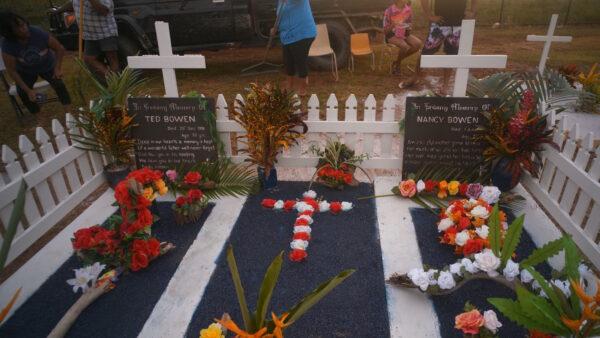
The Spirit of Hope Vale is on Display During the Annual Easter Events
The sun dawns on the Saturday before Easter.Their picnic baskets packed and thermos’ filled with tea, the people of Hope Vale descend on the cemetery.
People get busy working on the graves as puffy white clouds zoom overhead from behind Table Top Mountain.
Perched on the edge of a grave blossoming with flowers amidst the hustle and bustle, Cheryl explains that people always make it home for Easter to take part in this celebration.
Across the way, sitting in front of his family’s plot, Danny Gordon backs this sentiment up, saying, “You can take the people out of Hope Vale, but you can’t take Hope Vale out of the people.”
Around him, it’s all action stations.
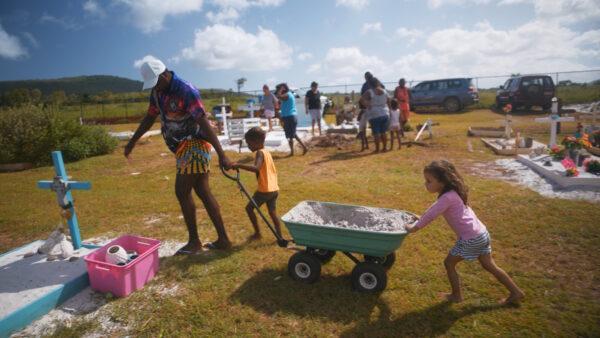
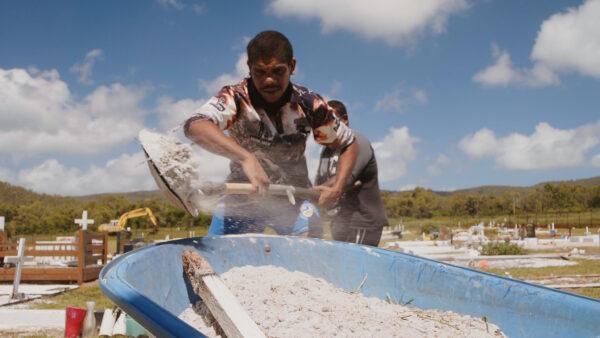
People rake, chop, paint, place fresh flowers, haul white sand in wheelbarrows, and cart weeds to the skip. It’s a flurry of activity.
Alice Walker says this is how the Guugu Yimidhirr people show respect for the people who came before them and built Hope Vale.
The Sun Dances on Easter Sunday.
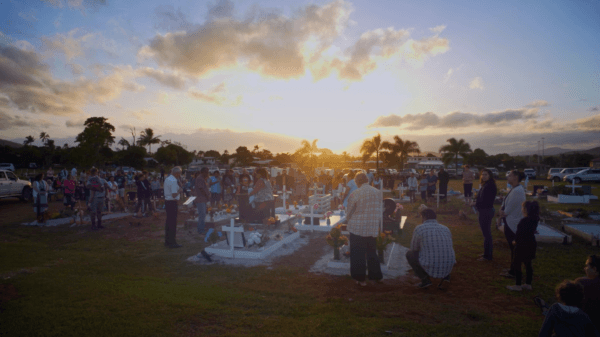
Bathed in the glow of the dawn’s early light on Easter Sunday, a large crowd of the faithful have gathered at the cemetery.
Pastor David Spanagal opens the dawn service, and the choir sings once again. Five brand new gravestones are unveiled. Pastor David offers a blessing at each. He says the dawn service happens every year and “came out of the heart of the people.”
Young Jaharis Gibson (13) sings a dedication at his grandmother’s gravestone. He says it’s to honour her.
Phylamena says it gives her great joy to take part in the tradition, and she hopes to be alive for next year’s event (she got her wish).
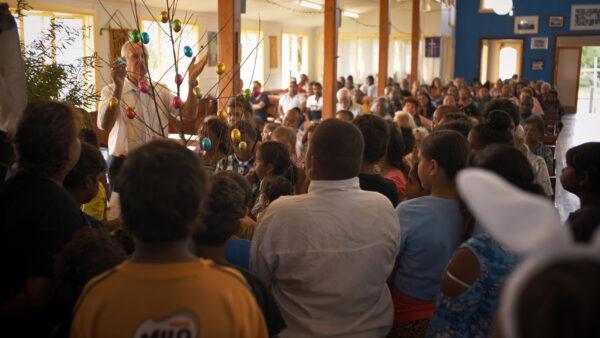
A few hours later, the regular Sunday church service is packed to the rafters.
Children sing and collect Easter Eggs from the pastor, the choir performs once again in front of the congregation, and two more babies are baptised.
As the congregation takes communion, a young boy sings a hymn solo, sounding very Johnny Cash.
Tammy and the choir, accompanied by Dora, Dorothy and the band, perform a rendition of the 1899 American spiritual, “Were You There When They Crucified My Lord.”
Some of Hope Vale’s residents reflect on the week that has been and what it means to them.
“The church was filled with people this morning. Yet the tide is good [for fishing], but people are here in the church,” says Shirley.
“We have nothing in our lives if we don’t have a belief,” she adds.
Estelle recalls how the old people would say of their deceased loved ones, “They mightn’t be here today, but we’re gonna meet them back in heaven.”
While holding her autoharp to her chest, Dorothy says with a serene smile: “I wake up in the morning, I open the window; this is the day that the Lord has made, I will rejoice and be glad in it.”
For Doreen, Palm Sunday is special because her father didn’t know his date of birth. It wasn’t registered in those days for Aboriginal people because of the laws.
“So it became a custom for them over the years to celebrate Palm Sunday as their birthday. So that’s why Palm Sunday’s special to me because it’s my father’s birthday,” she says.
Debbie says she can’t forget her upbringing by her parents, who were active in the church, where her father taught Sunday school, and their legacy “to follow Jesus right up to the cross, and until his resurrection on Easter morning.”
Debbie says, “If you’re a believer and you base your faith on the Apostolic and the Nicene Creed, then Easter is one of the best times of the year. Every other event throughout the calendar year is just events, but this is what I personally base my faith on.”
Shirley says, “It’s important to know that life happens. Life is happening. And you continue living because this is history. You create history.”
June, sitting at the organ, reads a note she’s prepared.
“In recent years, we as a community have decided to have a dawn service at the gravesite of our loved ones. And as a community, we come together, and we care for each other and make sure we help each other at the cemetery. We prepare for the dawn service, and people just generally go all out to prepare the cemetery so that it’s looking like a beautiful garden. And that’s what reminds me and gives me the picture that heaven must be like that. You know, a garden where our loved ones lie.”

